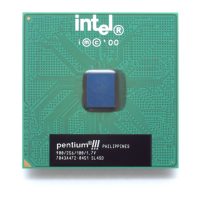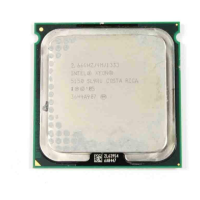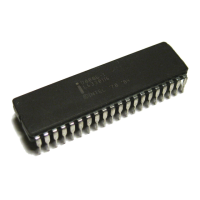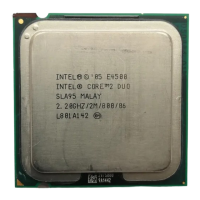Datasheet 83
Thermal Specifications and Design Considerations
5.2.7 Thermal Diode
The processor incorporates an on-die thermal diode. A thermal sensor located on the system board
may monitor the die temperature of the processor for thermal management/long term die
temperature change purposes. Table 5-4 and Table 5-5 provide the diode parameter and interface
specifications. This thermal diode is separate from the Thermal Monitor’s thermal sensor and
cannot be used to predict the behavior of the Thermal Monitor.
§
Table 5-4. Thermal Diode Parameters
Symbol Parameter Min Typ Max Unit Notes
I
FW
Forward Bias Current 11 187 µA
1
NOTES:
1. Intel does not support or recommend operation of the thermal diode under reverse bias.
n Diode Ideality Factor 1.0083 1.011 1.023
2, 3, 4, 5
2. Characterized at 75 °C.
3. Not 100% tested. Specified by design characterization.
4. The ideality factor, n, represents the deviation from ideal diode behavior as exemplified by the diode equation:
I
FW
= I
S
* (e
qV
D
/nkT
–1)
where I
S
= saturation current, q = electronic charge, V
D
= voltage across the diode, k = Boltzmann
Constant, and T = absolute temperature (Kelvin).
5. Devices found to have an ideality factor of 1.0183 to 1.023 will create a temperature error approximately 2 C° higher than
the actual temperature. To minimize any potential acoustic impact of this temperature error, T
CONTROL
will be increased by
2 C° on these parts.
R
T
Series Resistance 3.242 3.33 3.594 Ω
2, 3, 6
6. The series resistance, R
T
, is provided to allow for a more accurate measurement of the thermal diode temperature. R
T
, as
defined, includes the pins of the processor but does not include any socket resistance or board trace resistance between
the socket and the external remote diode thermal sensor. RT can be used by remote diode thermal sensors with automatic
series resistance cancellation to calibrate out this error term. Another application is that a temperature offset can be manu-
ally calculated and programmed into an offset register in the remote diode thermal sensors as exemplified by the equation:
T
error
= [R
T
* (N-1) * I
FWmin
] / [nk/q * ln N]
where T
error
= sensor temperature error, N = sensor current ratio, k = Boltzmann Constant, q = electronic
charge.
Table 5-5. Thermal Diode Interface
Signal Name Land Number Signal Description
THERMDA AL1 diode anode
THERMDC AK1 diode cathode

